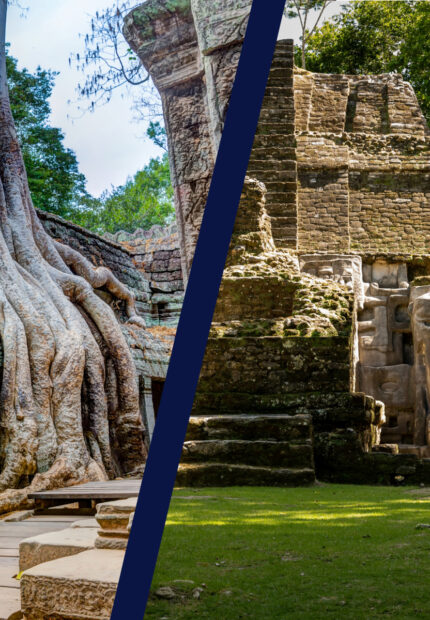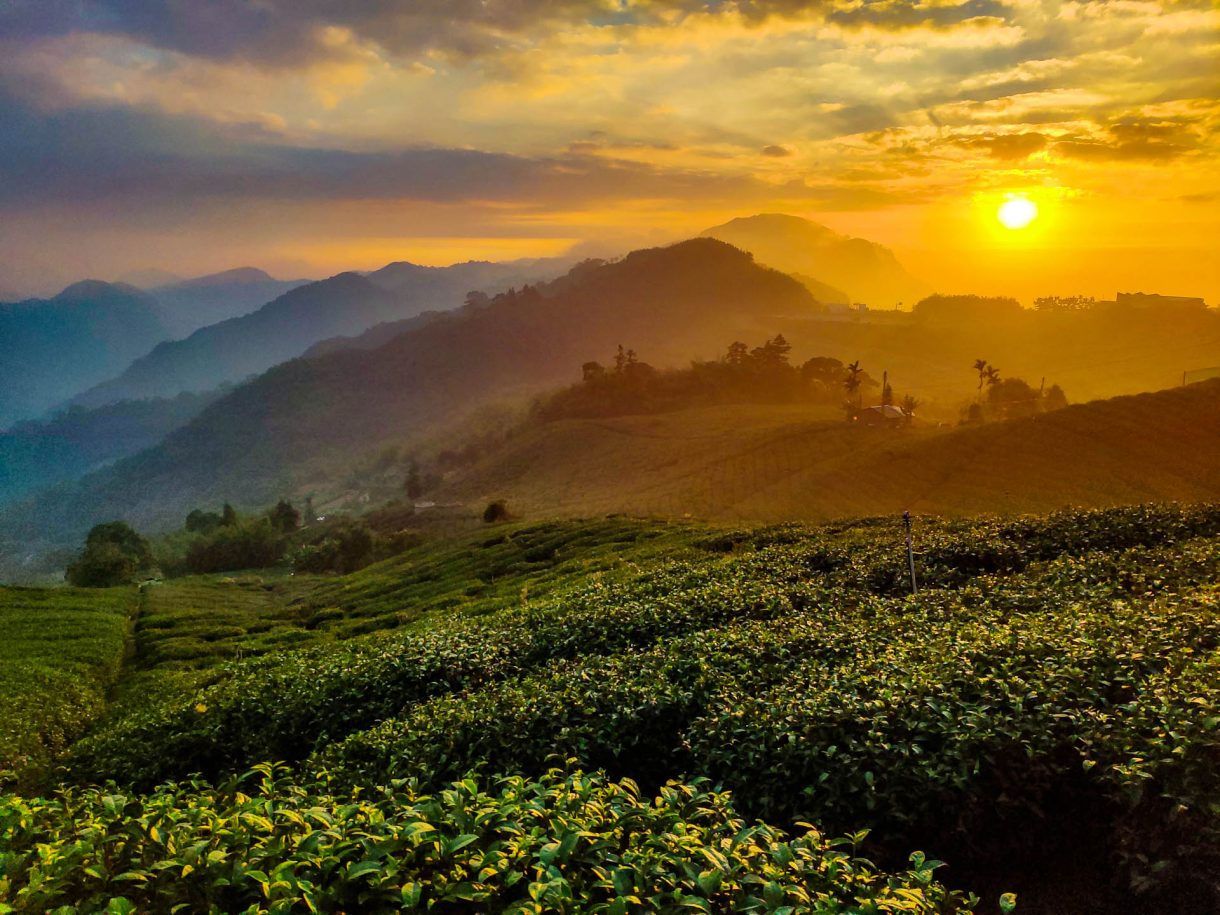
Avoid tourists in Taiwan with this hidden Tea Trail [2023]
With valleys of tea and clouds drifting dreamily through, the Alishan region of Taiwan is a must-visit on any traveller’s bucket list. This guide will help you plan your trip to the tea trails near the Shizhuo (石棹) village, a scenic area overlooked by many tourists. We’ll cover the trail route, how to get there, where to stay, and more!
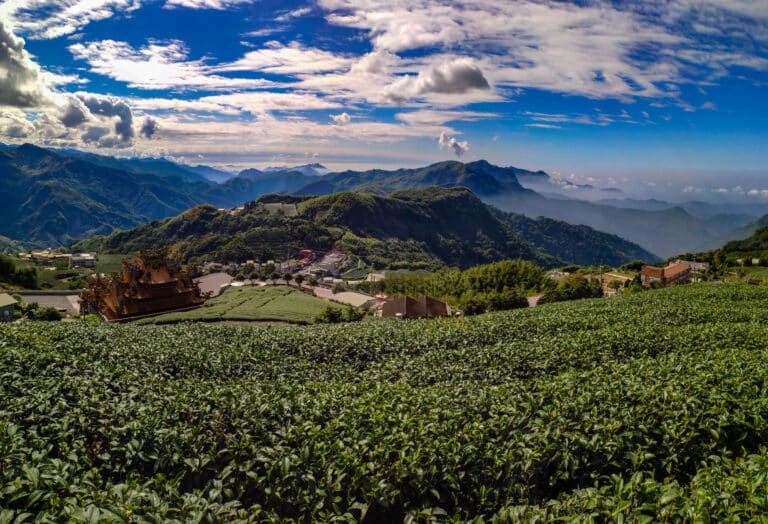
Views you can expect on our unique circular route
WHAT ARE THE SHIZHUO TEA TRAILS (石棹步道群)?
Alishan National Forest is celebrated for its breathtaking scenery. With its dramatic mountains, deep valleys, and ancient forests – some parts of which are over 1000 years old – Alishan is one of Taiwan’s most popular tourist destinations. The area is particularly famous for its sea of clouds, especially during sunrise, creating a surreal atmosphere.
But all the tourists make this tranquil forest less peaceful. What can a traveller do when they want to escape the crowds?
Set in the foothills of the Alishan Mountains, between the Taiwanese city of Chiayi and the famous Alishan Forest, Shizhuo and Fenchihu (sometimes spelt Shizhao and Fenqihu) are two tiny mountain villages that are easily overlooked when planning your trip to Taiwan. However, they not only make an excellent (and oftentimes cheaper) base for exploring the extraordinarily popular Alishan Forest Recreation Area, they’re well worth a visit in their own right.
Why, you ask?
Surrounded by sprawling jade-coloured tea fields, as far as the eye can see, a network of mossy forest hiking trails and gorgeous mountain views, Shizhuo and Fenchihu are great places to soak up the scenery, and enjoy the fresh mountain air away from the packed trails of Alishan National Forest. This tranquil alpine area and its stunningly beautiful tea trails is just begging to be explored.
WHY VISIT THE SHIZHUO TEA TRAILS?
Whether you’re after an adventure, or a dreamy escape, Shizhuo, Fenchihu, and their famous tea trails are the perfect place to go to escape the crowds of Alishan Forest. These overlooked tea trails, located near Shizhuo along the Alishan Highway, offer a quieter and less touristy alternative to the popular Alishan Forest Park.
Head up into the hills behind Shizhuo and you’ll find a network of five short-to-medium tea trails. Named for the oolong tea fields that they wind through, these gentle hiking routes will also take you through bamboo forests and past cherry trees. They all have the most beautiful names such as the mist trail, sunset trail, cloud trail, sakura trail and tea trail.
Easily accessible, these beautiful trails are made for wandering slowly. They’ll give you a closer look at the local tea culture for which Alishan is famous, and you can stop in multiple places to savour a cup of fresh local tea.
The longest is the ‘Tea Trail’ at just 1.8 km. The rest of the trails are less than 1km each. Our unique map below will show you a 5 km circular route that will take you along some of all of the Alishan tea trails in Shizhuo! We’ve also included some of our favourite insta-worthy photo spots!
TRAIL MAP - KEEP THIS HANDY!
Check out the map below for an overview of the route:
This circular tea trail, which I hiked during one of my trips to Taiwan, is around 5 km long. The tea trail will take you along parts of all of the trails in Shizhuo – the mist trail, sunset trail, cloud trail, sakura trail, and ‘tea trail’ – and takes around 2 – 3 hours.
I recommend that you take your time. Stop for a cup of tea, picked fresh from the fields (think of how low the food milage would be!), or spend some time capturing the scenery with your camera.
This hike begins with the mist trail, a steep path that will bring you above Shizhuo village. Here, you’ll start to get views of the tea plantations stretching across the hills in front of you. Following the path will take you along the Alishan Sakura Trail. You’ll eventually head through a bamboo forest, with an easily-navigatable wooden pathway to guide you.
This circular route then loops round to join the Cloud Trail, where, if you’re lucky, you’ll see the low-hanging sea of clouds drifting through the valleys of tea. Our route then connects with the ‘Tea Trail’, which will take you through the forest before stunning views of the plantations appear once more. Make sure to check out the Wu Feng temple on your way back!
There’s not a lot of information in English about these walks online, but they’re super easy to navigate! The start point of each trail is marked on Google Maps. Here, you’ll find an information board with a map of the route. All paths are very well made, well maintained, and clearly signposted in Chinese and English.
Top tip: Download the maps.me offline map for southern Taiwan. All the trails are clearly marked in there and it will help you to not get lost.
HOW TO GET TO THE TEA TRAILS?
GETTING TO ALISHAN TEA TRAILS BY BUS
A trip to the tea trail is best combined with the famous Alishan National Forest Recreation Area. Shizhuo, the starting village of the tea trails, is on the main road between the city of Chiayi (嘉義) and Alishan area (阿里山), so you can stop off on your way.
The regular bus 7322 between Chiayi and Alishan stops at Shizhou (石棹). The journey takes about 2 hours, but the last hour takes you along a winding mountain road – something to consider if you suffer from motion sickness!
The bus stop in Shizhuo to get off is at What3Words location: ///restored.blessings.strumming
You can find the bus timetable as of 2023 at this blog:
Make sure to double-check the departure times. Hotels, hostels, and tourist information points can help you with the language barrier. If you’re really stuck, you can do what I do, and approach a young-looking person. Young adults throughout the world are more likely to speak some level of English than their older relatives and can be really helpful if you’re in a pinch.
TOP TIP: We’ve written the names in Mandarin for a reason! Feel free to show them when. buying bus/train tickets or arranging a pick-up stop!
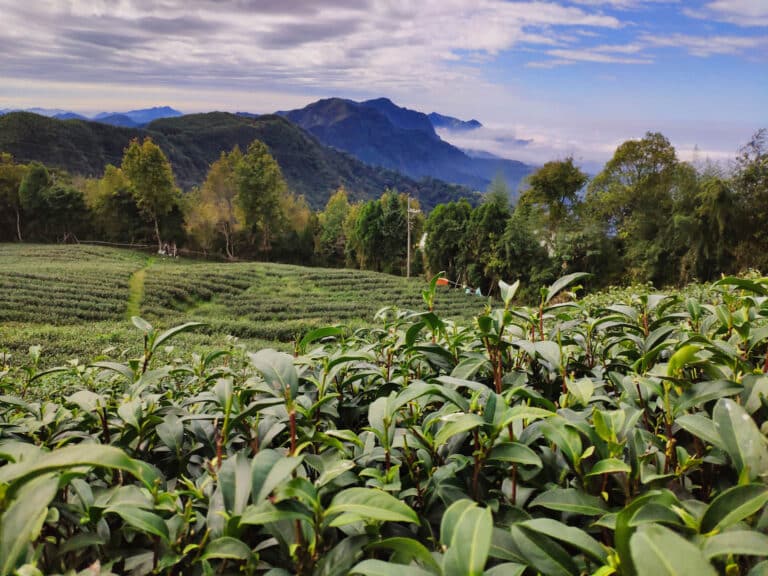
GETTING TO ALISHAN TEA TRAILS BY TRAIN
The famous Forest Rail, built by the Japanese in 1912 to transport wood, is now a famous tourist attraction which connects the city of Chiayi to the Alishan area. Riding the train is an attraction in itself. It zigzags up the mountains, crossing through tunnels and over wooden bridges.
Unfortunately, the Shizhuo village is not directly served by the train but the stations Duolin (多林火車站) and Shitzulu (十字路) are not so far away. The ancient village of Fenqihu (奮起湖) is also worth a visit, with a station just 10km distance from Shizhuo. Most guesthouses in Shizhuo are happy to arrange a pickup for a small fee but make sure to arrange this in advance.
You can book your train ticket online. If you’re feeling spontaneous, you can also get your train ticket from the automatic ticket vending machine inside Chiayi Station or at the ticker counter.
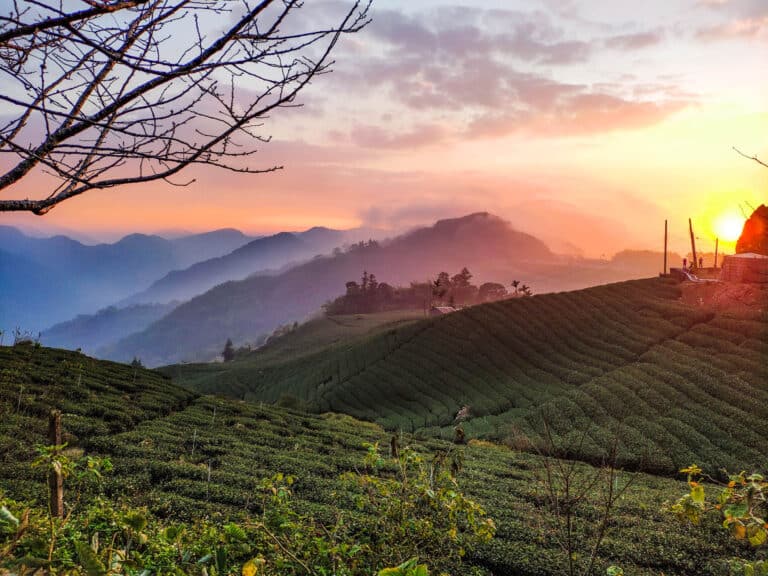
My teahouse was just down the road from this gorgeous view!
WHERE TO STAY IN SHIZHUO
Shizhuo is a great place to base yourself, even if you want to visit Alishan National Forest. It can be difficult to find accommodation in Alishan itself, especially in the high season as there are only a few accommodation choices. But Shizhuo has a lot of family-run guesthouses tucked between the tea plantations. Our favourite way of slow travel!
Cultivation of Taiwan’s celebrated High Mountain Oolong Tea first began in the village of Shizhuo. If you’re a tea-lover (like me!) this is the perfect place to base yourself before hitting up the tea trails. There’s plenty to do here, from tea picking, tea-factory tours and teahouse sessions. If you’re up for it, there’s lots more Taiwan tea trails in the vicinity too that we haven’t covered here.
TLDR: Basing yourself a little further out in Shizhuo leaves you surrounded by beautiful tea plantations, gently drifting clouds and fewer tourists. What could be more dreamy?
OUR FAVOURITE HOTELS, HOSTELS, AND HOMESTAYS IN SHIZHUO
- Satori Tea (悟 佐茶 )
This is where I stayed on my visit. Clean and comfortable with wonderful owners and complimentary tea in every room. You can also buy their home-grown tea leaves. - Alishan Lauya Homestay (阿里山神禾)
- Tianyi Homestay
OTHER AMAZING THINGS TO DO IN AND AROUND SHIZHUO
#1 SAMPLE ALISHAN'S FAMOUS HIGH MOUNTAIN OOLONG TEA
I used to drink a lot of tea, but these days I’m more into coffee (making it through an undergrad and a masters will do that to a girl!). Then again, you can’t come to Alishan and not taste its most famous product, Oolong tea.
The high elevation and cool mist that rolls through the hills creates the perfect conditions for growing Oolong tea. Traditionally, Alishan Oolong is steeped multiple times at set temperatures, to ensure you get the best possible flavour!
If you’re a slow traveller and want to get to the heart of Alishan’s tea scene, you’ll find numerous local tea farms in Shizhuo that will open up theiok one of these homestays in Shizhuo, where you’ll be expected to savour cup after cup of steaming tea.
#2 VISIT THE WUFENG TEMPLE
The Wufeng Temple, also known as the Alishan Zhongwang Temple, is a beautiful temple that you can visit at the start or the end of our circular tea trail (it’s marked on the map). This temple is simple, elegant, and free to enter.
Top tip: Afternoon fog is a frequent occurrence in the Alishan region and and temperatures can drop dramatically. Get an early start and always bring a jacket!
#3 CLIMB THE DINGHU TRAIL TO THE PEAK OF DADONGSHAN
This steep 5km hike is a short distance from Shizhuo! Follow the switchback through a magical forest, along mossy trails and through bamboo groves to the peak of Dadongshan. On a clear day, you’ll get some stunning views.
The trailhead is 6 km north of Shizhao so you’ll need to take a taxi or arrange a lift with your guesthouse. Unless you have transport arranged for the way back, I recommend returning from the summit the same way that you hiked up.
LIKE IT? PIN IT!
DON’T FORGET! SAVE THIS TO YOUR PIN BOARD TO REMEMBER IT FOR LATER
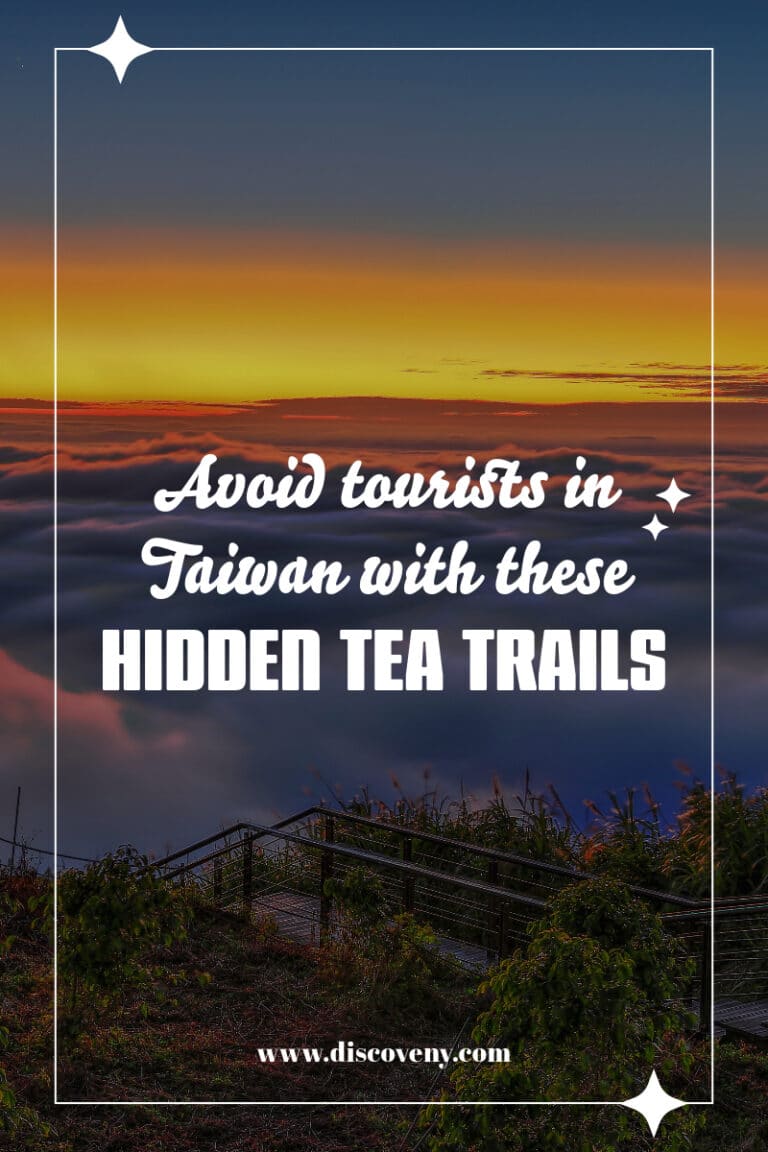
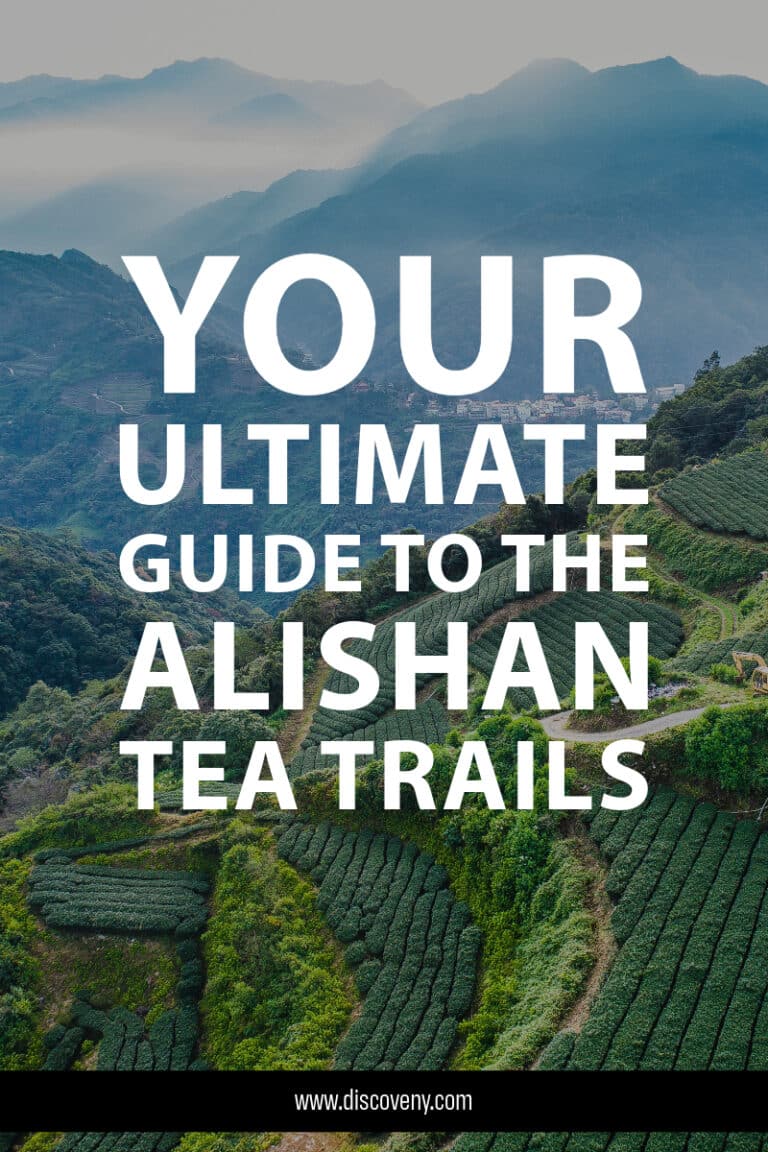
We hope this guide has inspired you to venture away from the beaten track and sip, savour, and explore the tea trails of Shizhuo, Alishan. We’d love to hear what you think! If this blog helped you, or if you have anything to add, leave us a comment or connect with us on Instagram. We look forward to hearing from you!
Disclaimer: The information and advice provided in this blog are the author’s opinions and based on their personal experiences. All information was accurate at the time of writing. However, things can change quickly, so always double-check current conditions and guidelines before setting out. Remember, your travels and safety are your own responsibility, and this blog can not be held responsible for anything that might happen on your adventures! Always exercise caution and good judgment. Oh, and don’t forget to get travel insurance! Happy travels!
This post may contain affiliate links (yay for transparency!) This means that I will earn a small commission, at no additional cost to you, if you click the link and choose to buy the product. I only link to stuff I have personally bought and found useful and never endorse crap. Your support helps keep the site going, thank you!
Marius
Marius is a German national recently returned to Europe from 2 years in Hong Kong. He's an expert on all things Asia and loves green tea and good hikes.
You May Also Like

Hiking the Annapurna Circuit in Monsoon Season: the Ultimate Guide [updated 2025]]
July 13, 2018
Is your Travel Photography Ethical?
February 19, 2022